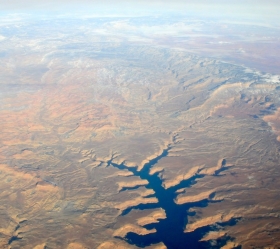Climate change to hit American West water supply

Climate change could cut water flow in some of the American West's biggest river basins -- including the Rio Grande and the Colorado -- by up to 20 percent this century, the Interior Department reported on Monday.
This steep drop in stream flow is projected for parts of the West that have seen marked increases in population and droughts over recent decades, Interior Secretary Ken Salazar said in a telephone briefing.
"These changes will directly affect the West's water supplies, which are already stretched in meeting demands for drinking, irrigating crops, generating electricity and filling our lakes and aquifers for activities like fishing, boating and to power our economy," he said.
A new Interior Department report outlines increased risks to water resources in the U.S. West for the 21st century, including:
- a temperature increase of 5-7 degrees F (2.77 to 3.88 degrees C);
- more precipitation where it's already wet (northwestern and north-central parts of the American West) and less where it's already too dry (southwestern and south-central parts);
- a decrease in April 1st snowpack, a standard benchmark measurement used to project river basin runoff;
- an 8 to 20 percent decrease in average annual stream flow in several river basins, including the Colorado, the Rio Grande, and the San Joaquin.
"Climate change will add to the challenges we face, which will be felt first in the Western United States," said Anne Castle, the Interior Department's assistant secretary for science and water. She noted that some of the fastest population growth has occurred in the driest areas, including parts of Nevada, Arizona, Utah, Idaho and Texas.
"Water is on the leading edge of climate change, so many of these basins have already experienced significant ... decreases to water supply," Castle said.
Water managers in the U.S. West are already emphasizing water conservation and efficiency, Castle said, adding that they are increasingly focusing on "the energy-water nexus."
"People are paying greater attention to the water demands of energy development and recognizing that conservation of energy can mean conservation of water as well," she said.
Salazar said "alarm bells" about the West's water supplies were sounding across the U.S. political spectrum, and that he himself felt the need for an "urgency of planning" to deal with the issue.
The eight river basins covered by the report are:
-- the Colorado, which supplies water to Arizona, California, Colorado, Nevada, New Mexico, Utah and Wyoming;
-- the Columbia, which flows through Washington state and Oregon, with more than 400 dams that provide hydropower, irrigation, flood control, stream-flow regulation and water;
-- the Klamath, which flows through Oregon and picks up water from northern California rivers, providing irrigation for crops and recreation facilities;
-- the Missouri, the longest U.S. river with a watershed of more than 500,000 square miles (1.295 million sq km) from Montana to Missouri;
-- the Rio Grande, which provides irrigation, households and recreation with water in Colorado, New Mexico, Texas and parts of Mexico;
-- the Sacramento-San Joaquin, which supplies California's Central Valley and cities including the San Francisco Bay area;
-- the Truckee, which includes the Lake Tahoe watershed and the headwaters along the eastern slope of the Sierra Nevada.
The full report and other related documents are available online at www.usbr.gov/climate/ .
(Editing by Cynthia Osterman)
![]()
© Thomson Reuters 2010 All rights reserved